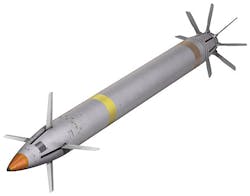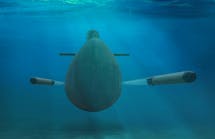Navy asks Lockheed to test and fine-tune LRLAP smart munitions for shipboard gun systems
WASHINGTON, 12 May 2016.Test and measurement experts at Lockheed Martin Corp. are fine-tuning long-range smart munitions for deployment aboard the U.S. Navy Zumwalt-class land-attack destroyer.
The gun shell, when perfected, will be able to hit land targets from ships offshore at ranges as far as 63 miles with near-pinpoint accuracy, experts say.
Officials of the Naval Sea Systems Command in Washington announced a $7.7 million contract Wednesday to the Lockheed Martin Missiles and Fire Control segment in Orlando, Fla., for test and measurement work involving the Long Range Land Attack Projectile (LRLAP).
The rocket-assisted LRLAP is the only munition capable for use with the MK 51 gun weapon system aboard the DDG 1000 destroyer. LRLAP provides the naval surface fire support and land attack warfare mission capability, Navy officials say.
Lockheed Martin, the LRLAP manufacturer, will perform engineering services for component requalification, safety testing, and initial operational test and evaluation support analyses and telemetry development for the LRLAP.
The 155-millimeter shipboard smart munition is the primary projectile of the Advanced Gun System (AGS), the main armament of the U.S. Navy’s next-generation DDG 1000 Zumwalt-class destroyer. It provides long-range offshore precision fire support to Marine Corps and Army forces engaged in expeditionary assaults or for urban operations near coastlines.
The 155-millimeter LRLAP is the most accurate and longest-range guided projectile in U.S. Navy history, with a maximum range in excess of 63 nautical miles, Lockheed Martin officials say. It’s precision and near-vertical angle of fall enable the Warfighter to destroy targets in the urban canyons of coastal cities with minimal collateral damage.
The Advanced Gun System firing the LRLAP has about the same destructive power as a battery of six 155-millimeter M109 Paladin howitzers, and can fire smart munitions in sequence such that several rounds hit their target at the same time.
The LRLAP system provides high-volume fire support at a rate of 10 rounds per minute through the depth of its magazine, Lockheed Martin officials say. It uses advanced guidance electronics hardened to withstand the effects of devastating G forces as the smart munition shoots from the cannon.
Its G-hardened electronics include a Global Positioning System (GPS) and inertial measurement unit to withstand the punishing gun-launch environment, Lockheed Martin experts say.
155-millimeter LRLAP can destroy a wide range of targets, and has three times the killing power of traditional 5-inch naval gun shells, Lockheed Martin officials say.
Because the LRLAP is guided, fewer rounds can produce similar or more devastating effects at less cost. LRLAP can guide several rounds launched from the same gun to strike one or many targets simultaneously.
On this contract Lockheed Martin will do the work in Orlando, Fla.; Keyser, W.Va.; Minneapolis; Burnsville, Minn.; White Sands Missile Range, N.M.; and Cedar Rapids, Iowa, and should be finished by May 2017.
For more information contact Lockheed Martin Missiles and Fire Control online at www.lockheedmartin.com/us/mfc, or Naval Sea Systems Command at www.navsea.navy.mil.

John Keller | Editor
John Keller is editor-in-chief of Military & Aerospace Electronics magazine, which provides extensive coverage and analysis of enabling electronic and optoelectronic technologies in military, space, and commercial aviation applications. A member of the Military & Aerospace Electronics staff since the magazine's founding in 1989, Mr. Keller took over as chief editor in 1995.




